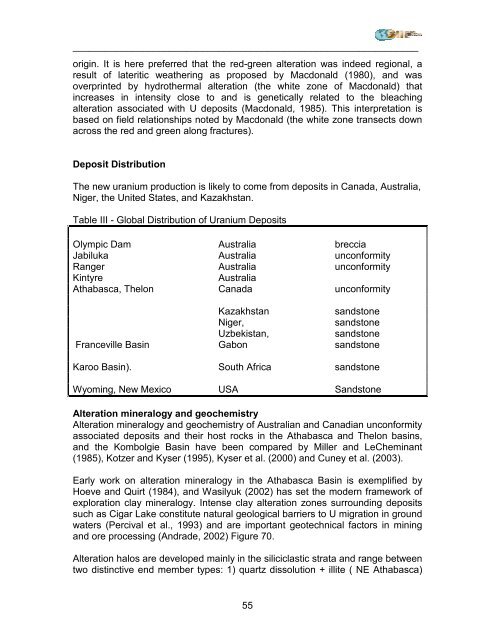An overview of vis-nir-swir field spectroscopy - Spectral International
An overview of vis-nir-swir field spectroscopy - Spectral International
An overview of vis-nir-swir field spectroscopy - Spectral International
Create successful ePaper yourself
Turn your PDF publications into a flip-book with our unique Google optimized e-Paper software.
________________________________________________________________<br />
origin. It is here preferred that the red-green alteration was indeed regional, a<br />
result <strong>of</strong> lateritic weathering as proposed by Macdonald (1980), and was<br />
overprinted by hydrothermal alteration (the white zone <strong>of</strong> Macdonald) that<br />
increases in intensity close to and is genetically related to the bleaching<br />
alteration associated with U deposits (Macdonald, 1985). This interpretation is<br />
based on <strong>field</strong> relationships noted by Macdonald (the white zone transects down<br />
across the red and green along fractures).<br />
Deposit Distribution<br />
The new uranium production is likely to come from deposits in Canada, Australia,<br />
Niger, the United States, and Kazakhstan.<br />
Table III - Global Distribution <strong>of</strong> Uranium Deposits<br />
Olympic Dam Australia breccia<br />
Jabiluka Australia unconformity<br />
Ranger Australia unconformity<br />
Kintyre Australia<br />
Athabasca, Thelon Canada unconformity<br />
Kazakhstan sandstone<br />
Niger, sandstone<br />
Uzbekistan, sandstone<br />
Franceville Basin Gabon sandstone<br />
Karoo Basin). South Africa sandstone<br />
Wyoming, New Mexico USA Sandstone<br />
Alteration mineralogy and geochemistry<br />
Alteration mineralogy and geochemistry <strong>of</strong> Australian and Canadian unconformity<br />
associated deposits and their host rocks in the Athabasca and Thelon basins,<br />
and the Kombolgie Basin have been compared by Miller and LeCheminant<br />
(1985), Kotzer and Kyser (1995), Kyser et al. (2000) and Cuney et al. (2003).<br />
Early work on alteration mineralogy in the Athabasca Basin is exemplified by<br />
Hoeve and Quirt (1984), and Wasilyuk (2002) has set the modern framework <strong>of</strong><br />
exploration clay mineralogy. Intense clay alteration zones surrounding deposits<br />
such as Cigar Lake constitute natural geological barriers to U migration in ground<br />
waters (Percival et al., 1993) and are important geotechnical factors in mining<br />
and ore processing (<strong>An</strong>drade, 2002) Figure 70.<br />
Alteration halos are developed mainly in the siliciclastic strata and range between<br />
two distinctive end member types: 1) quartz dissolution + illite ( NE Athabasca)<br />
55


